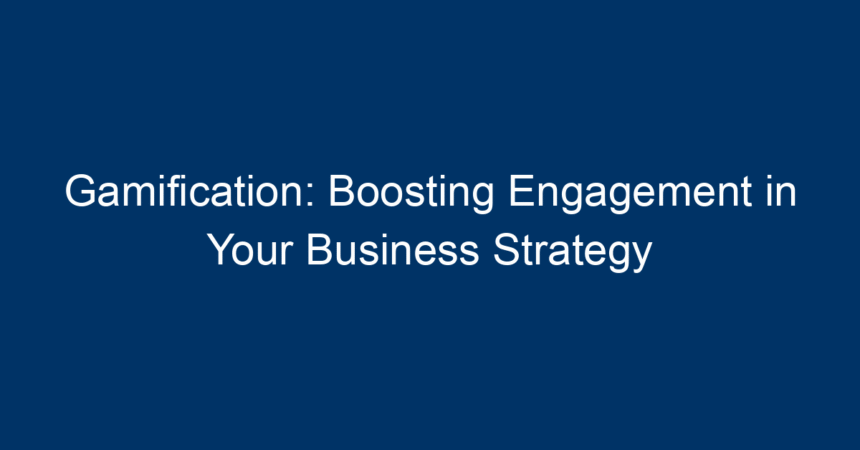In a world where attention spans are dwindling and competition is fiercer than ever, businesses are continuously seeking innovative ways to engage their customers and employees. One powerful approach that has emerged is gamification. This versatile strategy involves applying game-like elements in non-gaming contexts to motivate and enhance engagement. Whether you run a start-up or manage an established corporation, understanding how to leverage gamification can propel your business strategy to new heights.
What is Gamification?
At its core, gamification is the integration of game mechanics into different aspects of business to influence behavior and enhance participation. This concept applies psychological principles from gaming—such as competition, rewards, and achievement—to create systems that are engaging and enjoyable. Businesses utilize gamification to reward employees, enhance customer experience, and drive user engagement.
Why Gamification Works
The effectiveness of gamification lies in its ability to tap into intrinsic motivations. When games are designed well, they create a compelling, immersive experience that encourages users to participate willingly. By incorporating elements such as points, badges, and leaderboards, businesses can cultivate a sense of achievement and community among users.
Key Elements of Gamification
Understanding the components that make up effective gamification is crucial for any business looking to adopt this strategy. Here are some essential elements:
1. Points and Scoring Systems
Points are the simplest form of gamification, where users earn points for performing specific actions. This can range from completing tasks to achieving milestones. Organizations often use this to track engagement and encourage friendly competition.
2. Badges and Achievements
Badges serve as visual representations of achievement and are often awarded for reaching specific goals. This element not only provides recognition but also serves to motivate users to engage further.
3. Leaderboards
Leaderboards display user rankings based on points or achievements. This feature fosters competition and encourages users to strive for higher rankings, making the experience more engaging.
4. Challenges and Quests
Challenges create a sense of mission and purpose. By designing quests, businesses can guide users through a series of tasks that lead to significant engagement and retention.
5. Feedback Mechanisms
Instant feedback is a cornerstone of gamification. Regular updates on progress allow users to see their achievements and motivate them to continue participating.
Applications of Gamification in Business
The versatility of gamification has seen its adoption across various sectors. Here’s how businesses can implement it effectively:
1. Employee Engagement
In the workplace, gamification can enhance employee productivity and motivation. By introducing elements like point systems for performance and reward badges, organizations can create a more dynamic and competitive atmosphere. Gamified training programs help employees learn new skills in an engaging manner, turning mundane tasks into exciting challenges.
2. Customer Engagement
For marketing teams, gamification can significantly boost customer loyalty. Brands can create interactive campaigns that encourage customers to engage with their products or services actively. For instance, loyalty programs that reward points for purchases or social media interactions enhance the customer experience and drive repeat business.
3. Product Development Feedback
Gamifying feedback collection helps in product development by turning surveys into engaging interactions. Customers can earn rewards for completing quizzes or providing reviews, thereby increasing participation rates. This not only enhances customer engagement but also provides valuable insights for improvements.
4. Learning and Development
In educational settings, gamification can aid in creating interactive learning experiences. By incorporating game elements in training modules, companies can foster a culture of continuous learning. This approach not only improves knowledge retention but also makes learning more enjoyable.
Benefits of Gamification
Implementing gamification in your business strategy offers several significant advantages:
1. Enhanced Engagement
Gamification transforms mundane tasks into fun challenges, leading to improved engagement levels. Users are more likely to participate actively when they find the process enjoyable.
2. Increased Motivation
By rewarding users with points, achievements, and recognition, gamification fosters a sense of accomplishment. This motivation drives users to engage more consistently.
3. Improved Retention Rates
Whether it’s customers returning to a loyalty program or employees staying engaged in their roles, gamification can enhance retention. Users are more likely to continue their involvement if they feel a sense of purpose and reward.
4. Data-Driven Insights
Gamification provides businesses with valuable data regarding user behavior. By analyzing how users interact with these systems, companies can gain insights into preferences and adjust strategies accordingly.
Challenges of Gamification
While the prospect of implementing gamification in your business strategy is exciting, it’s essential to be aware of common challenges:
1. Over-Gamification
There is a risk of over-gamifying experiences, which can lead to user fatigue. It’s crucial to strike the right balance and ensure that the games remain enjoyable without being overwhelming.
2. Misalignment with Goals
Gamification strategies must align with your overall business goals. If they diverge, the gamification efforts may fall flat and fail to produce the desired results.
3. Lack of Authentic Engagement
If gamification is perceived as a gimmick rather than a genuine effort to engage users, it can backfire. Users may become skeptical and disengage from the experience.
Case Studies: Successful Gamification
1. Duolingo
Language-learning platform Duolingo effectively utilizes gamification to engage users in learning new languages. Users earn points for completing lessons, unlock levels as they progress, and compete on leaderboards. This approach has boosted user engagement and retention.
2. Fitbit
Fitness tracker brand Fitbit incorporates gamification into its user experience by allowing users to earn badges for reaching fitness goals, track their progress, and compete with friends. This has significantly increased motivation and user engagement in health and fitness activities.
Actionable Insights for Implementing Gamification
To successfully implement gamification in your business strategy, consider these actionable insights:
-
Know Your Audience: Understand what motivates your users. Tailor gamification elements to meet the preferences and needs of your target audience.
-
Set Clear Objectives: Define what you want to achieve with your gamification efforts—be it increasing sales, improving employee morale, or enhancing customer engagement.
-
Keep It Simple: Start with basic elements and gradually introduce complexity as users become comfortable with the system. Avoid overwhelming users at the initial stage.
-
Gather Feedback: Continually solicit feedback from users to refine your gamification approach. Adjust based on what works and what doesn’t.
- Monitor and Analyze: Use analytics to track user interactions and measure the effectiveness of your gamification strategy. Data can inform future improvements and adaptations.
Conclusion
In a landscape brimming with competition, gamification offers a unique lever to boost engagement and drive success. By integrating this strategy into your business framework, you create a compelling experience that not only motivates users but also aligns with your goals. Whether you aim to enhance employee productivity or foster customer loyalty, gamification is a powerful tool that can revolutionize how you engage with your audience. Start small, gather insights, and watch as your engagement levels soar. The future of your business engagement strategy could very well depend on how you harness the power of gamification today.




